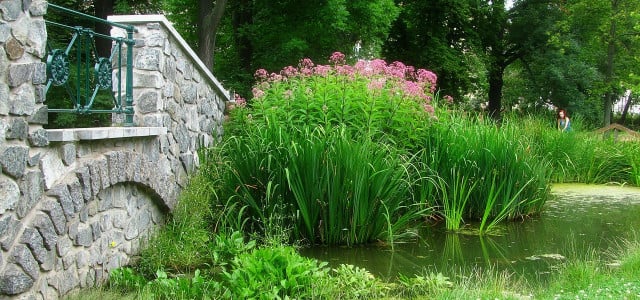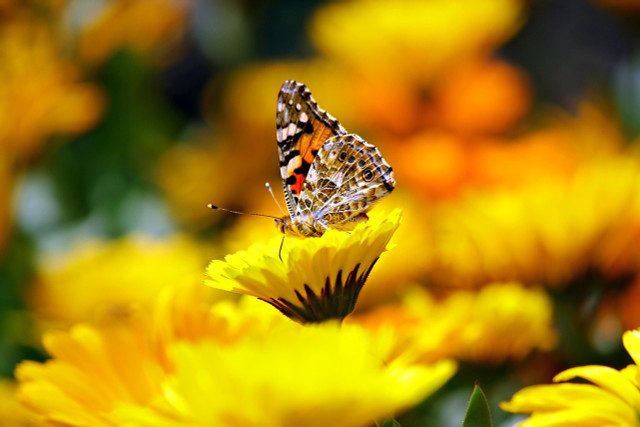
Feng Shui in the garden has a history of thousands of years. Rules and tips for garden design according to the Asian teaching of harmony you get here.
Contents
Feng Shui – teachings of balance
The teachings of Feng Shui are about the harmonious design of our living spaces. The aim of Chinese wisdom is to create and maintain a balance between the central forces of Yin and Yang. Our environment should be designed to radiate harmony, which is also transmitted to the human body. Feng Shui is known in our western world mainly for interiors. However, its basic principle can be applied in a very similar way to the garden.
Feng Shui in the garden
According to the teachings of Feng Shui, people are in constant interaction with the outside world. According to Daoist belief, there is energy not only in us, but also in everything that surrounds us: Qi (or “Chi”). In order for this energy to flow steadily, the highest goal in Feng Shui is to keep our interior and exterior in optimal balance. Wind (Feng) and water (Shui) represent the alternating poles in the world, which balance each other.
When designing a garden according to Feng Shui, it does not matter how much you believe in the effects of Chinese teachings. Nor do you have to use exclusively Asian plants. Feng Shui can be implemented just as well with native plants.
Design of the Feng Shui garden with the Bagua pattern
To design your garden according to Feng Shui patterns, you should first think through its basic structure. Helpful for a harmonious division of your garden area is the so-called Bagua pattern. According to this Chinese trigram, eight elements of equal size represent the central building blocks of our lives. At the center is a ninth element: life energy (or Tai Chi). In a certain arrangement, all areas are supposed to strengthen and balance each other. The harmony created should thus also have an effect on the garden visitor.
Depending on the size of your garden, the pattern can be realized in different ways. The nine segments do not always have to be designed on a large scale. You can use what they stand for as a guideline even in a smaller garden.
This is what the nine zones of the bagua stand for in detail:
- Career: According to Feng Shui, success in the private and professional spheres are located in the first section. The segment is oriented to the north and should be characterized by the element of water. Accordingly, colors in deep blue or black are suitable. For example, orchids or bellflowers are recommended as plants. Curved paths or watercourses also support the element of water in the first garden area.
- Education and Knowledge: The knowledge area in the northeast should stand for pause and silence. Calm colors such as yellow or brown support the element of earth and should promote concentration and self-knowledge here. A sheltered sitting area for retreat is particularly well placed in this part of the feng shui garden. In terms of plants, stone plants and perennials in soft earth tones are a good choice.
- Family and health: In the third segment in the east, chi is supposed to provide vitality, health and movement. Fast growing plants, watercourses and strong colors, but also elements of wood support the liveliness of this area. You can add seating to the family area in the feng shui garden, where you can recharge your batteries with family and friends.
- Wealth and finances: In the southeast, vigorous plants and trees should support spiritual as well as material wealth. You can also place large flower pots or decorative elements here. The best colors for the fourth Bagua segment are green and blue-green.
- Glory: The element of fire is assigned to the segment in the south. The segment symbolizes the reputation and wisdom of the inhabitants. Fittingly, this area of the feng shui garden is suitable for the creation of a fireplace or strong light sources. Powerful, fragrant flowering plants are especially good in this area. Suitable colors are red, orange or bright yellow.
- Partnership: The segment in the southwest should stand for the care of our interpersonal relationships. According to Feng Shui teachings, balance should be especially ensured here. Simple, square beds without many frills are often found here. The area also represents the element earth. Earthy tones such as yellow or brown are recommended. You can also create a rock garden well in the second segment.
- Children and creativity: This garden segment according to Feng Shui stands for the element metal. Everything that makes your children happy belongs here: slide, sandbox, swings or small caves made of branches. Let your children design this area themselves. Everything here should stand for cheerfulness. As for plants, fruit bushes, vegetables or berry bushes fit here especially well. Fresh, cool colors are ideal.
- Friends: The segment oriented to the northwest also contains metal as an element and stands for the support of and by our fellow human beings. Cool colors like white or silver, as well as metallic elements are ideal for this area. Suitable plants include spring-like tulips, daffodils, or brightly blooming shrubs.
- The center: The central part in your Feng Shui garden according to Bagua pattern is the center. Surrounded by the eight different segments with strong opposing energy fields, everything should come to rest here. The center of your Feng Shui garden should therefore be free of everything. Here you can lay a simple lawn or pile up some gravel. In the center is especially true: less is more.
Tips for Feng Shui in the garden

In addition to the optimal arrangement of your garden, there are some very basic tips in Feng Shui garden design:
- Refrain from using chemical fertilizers. These not only disturb the harmony of your Feng Shui garden, but are also harmful to the environment and animals. It is better to use homemade organic fertilizers.
- Your Feng Shui garden should symbolize the course of life. You can take this quite literally: Give space to all living things in your garden and do not fight them. Ideally, people, plants, birds and insects will live together in harmony in your diverse garden.
- As with any form of garden design, you should also work as close to nature as possible in your Feng Shui garden. Use mainly native plants. You can also support insect diversity by planting bee-friendly perennials.


